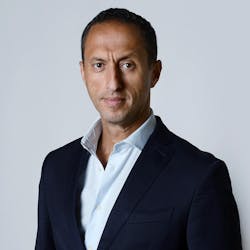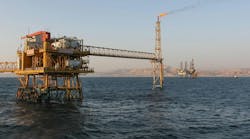ADIPEC 2025: DNV strategist on offshore asset resilience, AI integration and regulatory trends
Key Highlights
- Inspection now covers a broader scope, including turbines, export cables and high-voltage substations, reflecting the technological shift in offshore renewables and CCS.
- Global trends include harmonizing standards, local content frameworks and digital traceability, which improve project transparency, speed and quality outcomes.
- Early and continuous inspection practices help de-risk investments, prevent costly rework and keep complex offshore projects on schedule.
- Decades of oil and gas experience in risk management, safety culture and lifecycle integrity are directly applicable to new offshore low-carbon projects.
By Ariana Hurtado, Editor-in-Chief
As offshore energy projects diversify into renewables like wind, hydrogen and carbon capture, inspection and assurance practices are evolving to meet new technical and regulatory demands.
Ahead of ADIPEC 2025, Offshore chatted with Mohamed Houari, global managing director at DNV Inspection, about how inspection is adapting to support complex, multi-technology developments across global offshore markets. From fragmented supply chains to emerging standards, Houari shares insights on the challenges and opportunities shaping the future of offshore quality assurance. He also explores how inspection helps de-risk investment and accelerate timelines in the energy transition.
Offshore: How has the role of inspection evolved in offshore energy projects as the industry transitions toward low-carbon solutions like offshore wind, hydrogen and CCS?
Houari: As the energy transition accelerates, the number of low-carbon projects has grown sharply and so has the demand for inspection and assurance. The core purpose remains the same: ensuring assets are safe, compliant and built to perform.
What has changed is the scope of what is being inspected and the breadth of stakeholders involved. Offshore energy projects now integrate a mix of new technologies, global supply chains and partners from multiple industries.
This makes quality assurance and inspection even more vital. By applying our decades of experience in traditional energy inspection to domains like offshore wind, hydrogen and CCS, we help customers identify and manage risks early—providing the confidence to invest, build and operate safely.
Offshore: What are the key technical challenges DNV Inspection encounters when assuring quality and safety in emerging offshore renewables compared to traditional oil and gas projects?
Houari: Many fundamentals remain unchanged—safety, reliability, quality and compliance—but the assets, materials and supply chains are evolving rapidly. In offshore renewables, we’re now inspecting turbine components instead of pressure vessels, export cables instead of pipelines, and high-voltage substations instead of topsides.
The main technical challenges lie in:
- Younger, more fragmented supply chains: Manufacturing is spread across new geographies with varying levels of maturity in quality systems and inspection capability.
- Resource and competency pressures: The surge in renewable projects has created intense competition for skilled inspectors and engineers, making capability development and retention essential.
- Evolving technologies and materials: Many components lack long operational histories, limiting data on fatigue, corrosion and long-term performance.
- Standards and regulations catching up: Innovation is moving faster than certification frameworks, requiring close collaboration with regulators and developers.
Offshore: What trends are you observing in regulatory compliance and standards development for offshore inspection, particularly in regions like offshore the Middle East, the North Sea, Gulf of Mexico and offshore Brazil?
Houari: We’re seeing three global trends reshaping the inspection and compliance landscape:
- Alignment: Regulators are increasingly harmonizing standards across regions to streamline project execution. Offshore wind, hydrogen and CCS are now being governed with the same rigor historically applied to offshore oil and gas, improving consistency and reducing duplication.
- Localization: Markets such as the Middle East are strengthening local content frameworks linking assurance and workforce development to domestic capability. This builds local ownership while keeping global standards as the reference point.
- Digital traceability: The shift from static assurance to data-driven assurance enables earlier intervention, predictive insights and faster decision-making. Over time, this will transform assurance from a retrospective exercise into a continuous, value-adding process.
Together, these trends are driving greater transparency, faster approvals and more predictable, high-quality project outcomes across the global offshore energy sector.
Offshore: In your view, what role does inspection play in de-risking investment and accelerating timelines for offshore wind and hydrogen infrastructure projects?
Houari: Inspection is an effective practice for protecting investment and maintaining schedule discipline. When equipment and components are sourced globally, timely inspection ensures that what arrives offshore meets specification, integrates seamlessly and performs safely.
We tailor our inspection programs to each project’s risk profile, in many instances engaging as early as the design and vendor selection, monitoring quality through fabrication and installation, and commissioning. This end-to-end approach helps identify potential issues before they escalate, avoiding costly rework and keeping complex projects on track.
Offshore: How is DNV Inspection supporting workforce development and training to meet the evolving demands of offshore inspection in both legacy and emerging energy sectors?
Houari: The energy transition is reshaping the skills our industry needs. As DNV Inspection expands across low-carbon and renewable sectors, we’re investing in our people to ensure they can deliver with confidence across all energy domains.
Skills developed in oil and gas from materials integrity to vendor surveillance and quality assurance are highly transferable to offshore wind, hydrogen and carbon capture. We’re building on this foundation through targeted upskilling, digital training and global technical exchanges.
In the Middle East, a cornerstone of this effort is the Training Hub for Industrial Knowledge (THInK) in Abu Dhabi, the first of its kind in the region. Developed with industry partners, THInK blends classroom and hands-on learning to equip inspectors with the latest tools and standards. We also work closely with local training centers and our customers to develop national talent pipelines, training and certifying local graduates to strengthen the inspection workforce. This focus on localization builds lasting capability where projects happen and supports the long-term resilience of the energy ecosystem.
In Europe, we’re recruiting extensively to grow renewable-sector expertise, ensuring our workforce continues to evolve with the industry’s needs.
Offshore: What lessons learned from oil and gas inspection practices are proving most valuable in the context of offshore renewables and carbon capture projects?
Houari: Decades of oil and gas experience have given us a deep understanding of how to manage technical risk, supply-chain complexity and safety at scale, all of which are directly relevant to today’s low-carbon projects.
In offshore renewables and carbon capture, many of the same challenges reappear in new forms: large-scale fabrication, multi-vendor integration and demanding offshore environments. Proven practices such as risk-based inspection, vendor qualification and life-cycle integrity management remain central to ensuring reliability and safety.
Equally important are the project execution disciplines refined in oil and gas, clear documentation, interface control and early defect detection, which now underpin the quality assurance of turbines, substations, hydrogen modules and carbon capture systems.
Where the context differs, we adapt. For example, our oil and gas heritage in corrosion, materials and pressure systems helps inform inspection strategies for offshore wind foundations and hydrogen transport. We are also transferring the same safety culture and decision frameworks into renewables and CCS.
In short, the biggest lesson is that strong assurance principles are segment-agnostic; the same rigor that built confidence in oil and gas is now enabling safe, rapid growth in the low-carbon economy.
Offshore: Looking ahead, what innovations or strategic shifts do you anticipate will shape the future of offshore inspection over the next five years?
Houari: The next five years will reshape how inspection supports the energy transition. While the world is unlikely to reach net zero by 2050, DNV’s Energy Transition Outlook 2025 projects the global energy mix will shift from roughly 80% fossil today to about 50:50 by mid-century. That means inspection will increasingly operate across two fronts: maintaining the safety of existing assets while enabling rapid growth in low-carbon infrastructure.
Innovation will be driven by digitalization and data-led assurance. Predictive analytics and real-time monitoring will allow earlier risk detection and smarter deployment of expertise. Inspection will evolve from periodic to continuous assurance that improves efficiency and confidence.
Artificial intelligence will accelerate this change, particularly in data interpretation and anomaly detection. But human expertise will remain at the core, guiding judgment, ensuring context and keeping safety at the center of progress.
The future of inspection will be smarter, faster and more integrated, combining digital intelligence with human insight to deliver safe and efficient energy systems.
DNV will be exhibiting at booth 9157 in Hall 9 at the ADIPEC conference and exhibition from Nov. 3-6 in Abu Dhabi.
Offshore is a media partner of ADIPEC.
About the Author
Ariana Hurtado
Editor-in-Chief
With more than a decade of copy editing, project management and journalism experience, Ariana Hurtado is a seasoned managing editor born and raised in the energy capital of the world—Houston, Texas. She currently serves as editor-in-chief of Offshore, overseeing the editorial team, its content and the brand's growth from a digital perspective.
Utilizing her editorial expertise, she manages digital media for the Offshore team. She also helps create and oversee new special industry reports and revolutionizes existing supplements, while also contributing content to Offshore's magazine, newsletters and website as a copy editor and writer.
Prior to her current role, she served as Offshore's editor and director of special reports from April 2022 to December 2024. Before joining Offshore, she served as senior managing editor of publications with Hart Energy. Prior to her nearly nine years with Hart, she worked on the copy desk as a news editor at the Houston Chronicle.
She graduated magna cum laude with a bachelor's degree in journalism from the University of Houston.



